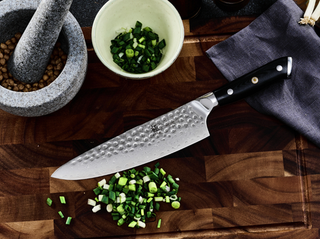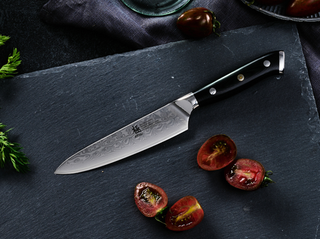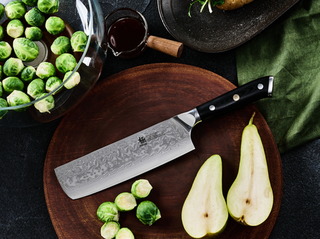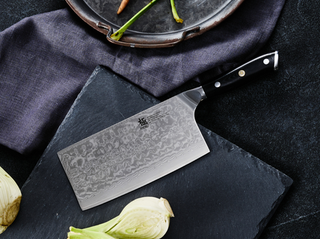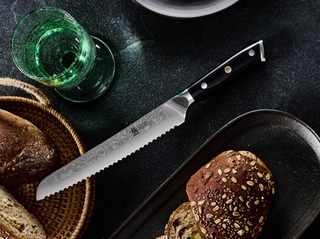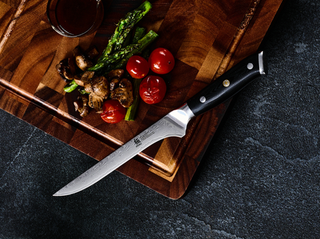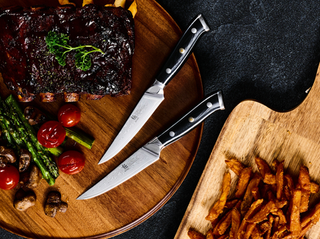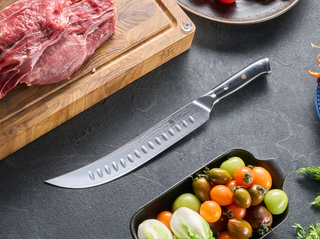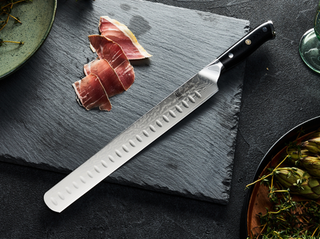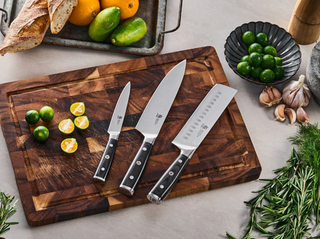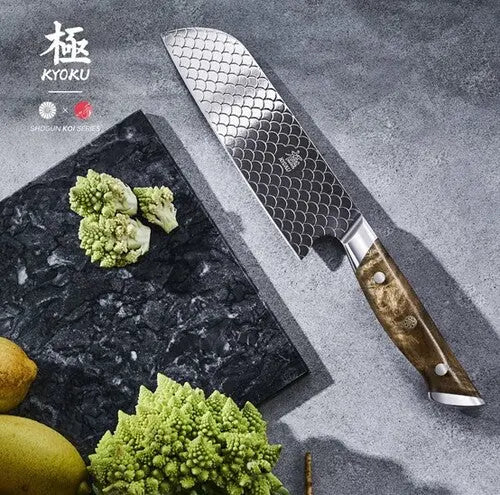For chefs and cooking enthusiasts alike, owning a set of Japanese knives is like having a secret weapon in the kitchen. With so many types of Japanese knives, each crafted for specific tasks, it’s no wonder they’re revered in the culinary world. Japanese cuisine, in particular, places a strong emphasis on using high-quality knives, making the right choice essential for precision and performance.
While the Gyuto Chef’s Knife and the Nakiri vegetable knife each serve their unique purposes, today, we’re turning our attention to the versatile Santoku knife. Known for its ability to effortlessly slice through delicate sushi and more, this knife is a game-changer.
In this blog, we’ll discuss Santoku knives for slicing sushi and what makes them stand out among other Japanese blades.
What are Santoku Knives?
Let us first discuss what are Santoku Knives. Santoku translates into English as 'three virtues' or 'three applications.' This knife has swiftly become a favorite among chefs and home cooks all around the world. Ideal for cutting, mincing, slicing, etc.. The Santoku knife is an all-rounder and extremely durable.
As you search, you may come across the phrase Bunka. This knife is normally the same as a Santoku, although some knife companies produce both with slightly different edge profiles. In the United States, Bunka is commonly used to refer to Kengata Santoku, a normal Santoku with a downturned tip. The Kengata Santoku is great for finer slicing and, let's be honest, looks good. The moniker Kengata means "sword-like," so it's no surprise they look fantastic.

Just like a chef's knife, the Santoku knife is somewhat shorter than the conventional Gyuto and is designed for smaller tasks, such as delicately slicing vegetables for a decorative garnish or chopping smaller portions for a meal. Also, why do Santoku knives have dimples? Many Santoku knives feature a dimpled surface to prevent tiny food particles from clinging to the blade. The Santoku blade is outstanding for a wide range of applications, and it is easy to use.
Characteristics of a Santoku Knife
Steel Types
Santoku knives are constructed from either stainless steel or high-carbon steel. Japanese steel is recognized for its increased carbon content, which results in a sharper edge and a thinner blade. Their slim design allows you to use santoku knives for slicing sushi and other food easily, relying on sharpness rather than raw force.
Superior Metal
The Japanese Santoku knife is a versatile cutting tool that makes use of high-quality Japanese steel and its superior material strength. Kyoku offers a variety of superior metal options to make long-lasting blades. The 7" Santoku Knife VG10 Damascus Steel comes with a VG10 steel core to create a long-lasting sharp edge for durability and performance. Having said that, correct maintenance practices should be used from the start to preserve the longevity of the blade.
Dimpled Edges
The majority of Santoku knives have dimples along the flat area of the blade. These indentations are designed to give a hollow or Granton edge. Resulting in an anti-suction sensation and decreased friction that doesn’t allow food to stick to the blade. Santoku knives are commonly used with vegetables and fruits; therefore, keeping fluids from clinging to the blade is advantageous.
Tall Blade
The Santoku knife is a multipurpose knife because of which it must have a tall and clean edge. The higher edge creates more space between the food and the blade, resulting in cleaner and more defined slices. You can effortlessly use santoku knives for slicing sushi and vegetables. This design allows the knuckles of your hand to cut right above the cutting board. It also provides a suitable surface for your free hand's knuckles to guide the blade during cutting and chopping.

Uses and Benefits of Santoku Knives
The Santoku knife has three main qualities or functions. This includes cutting, dicing, and mincing. Let's look at these uses in detail while also emphasizing some other useful Santoku knife applications.
Slicing
Like chef knives, you can use santoku knives for slicing sushi. The slices of these knives depend on the item needed to slice. Santoku blades are substantially flatter than traditional chef's knives, yet the upward curving edge allows for simple slicing action. To effectively practice slicing with a santoku knife, make sure the blade is entirely removed from the board and concentrate on the pulling or pushing action rather than the downward pressure. This method relies on the blade's design to perform the job, resulting in thin, crisp slices.
Dicing
The traditional Santoku knife is known for making precise slices. Santoku knives are excellent dicing and mincing instruments due to their precision. Unfortunately, there are some drawbacks. Santoku knives are somewhat less effective in rapid dicing than standard Western-style chef's knives. However, their slightly smaller blades allow them to be more dexterous.
Chopping
Santoku blades are renowned for their extraordinary sharpness. They can easily cut through items like cheese, fruits, veggies, nuts, herbs, and meat. Unrivaled mobility enables an experienced santoku knife user to glide through their chopping responsibilities. This is one of the ways the Santoku knife exceeds the greatest Western chef's knives.

Premium Range of Japanese Knives
If you want efficient and high-performing knives, check out Kyoku's range of chef knives, steak knives, and much more.
7" Japanese Damascus Santoku Knife
This 7-inch Santoku knife, made from 67 layers of stainless Damascus steel, is a work of accuracy and durability. Its razor-sharp edge glides easily through meat, fish, vegetables, fruits, etc. Making slicing and dicing simple and efficient.
7" Santoku Knives 440C Steel
This is a lower-priced alternative. This 7-inch Santoku knife is a great blend of history and technology, made with vacuum-heated Japanese stainless steel for exceptional durability. Because of its scalpel-like 13-15 degree edge, it combines the best attributes of a chef's knife and a cleaver to slice with minimum resistance, making it ideal for cutting meat, fish, vegetables, and other items with careful accuracy.
Final Thoughts
You can use Santoku knives for slicing sushi and other small items. There are different kinds of santoku knives at Kyoku, which you can use according to your needs and budget. In simple words, a santoku knife is an all-in-one knife, and if you want one knife rather than a collection that you can do different tasks with, go for this.
